Panasonic Lumix DMC-FZ30By: Dave EtchellsPanasonic's latest in the Lumix lineup, with an eight-megapixel sensor and high quality long-zoom Leica optics. <<Video, Power, Software :(Previous) | (Next): Reference: Datasheet>> Page 13:Test Results & ConclusionReview First Posted: 01/18/2006 |
"Gallery" Photos
For those readers interested in a set of less "standardized" photos from the Panasonic Lumix DMC-FZ30, we've put together a "photo gallery" of more pictorial shots captured with the FZ30.
We ran the Panasonic Lumix DMC-FZ30 through our usual battery of tests, and have summarized our findings here. To see the full set of our test images, with explanations of what to look for in them, see the Panasonic Lumix DMC-FZ30 Sample Pictures page. For a complete listing of all our test and "gallery" shots, go to the Thumbnails page.
A collection of more random, pictorial images can be found in the Panasonic Lumix DMC-FZ30 Photo Gallery.
Not sure which camera to buy? Let your eyes be the ultimate judge! Visit our Comparometer(tm) to compare images from the DMC-FZ30 with those from other cameras you may be considering. The proof is in the pictures, so let your own eyes decide which you like best!
Lens
Zoom
A broad, 12x optical zoom range. Pretty good performance overall.
35mm |
420mm |
4x Digital Zoom |
The DMC-FZ30 zooms over the equivalent of a 35-420mm range, which is quite a large range, and very flexible. Performance is good at both wide angle and telephoto, though a moderate amount of coma distortion is visible at wide angle. The 4x digital zoom takes it out to 48x total, though with significant blurring and loss of detail.
Macro
A small macro area with good detail and high resolution. Flash is blocked by the lens though.
|
Standard Macro
|
Macro with Flash
|
The DMC-FZ30's macro setting performs well, capturing a small minimum area of 2.10 x 1.57 inches (53 x 40 millimeters). Detail is strong and resolution high, though with fairly strong blurring in the corners of the frame from lens distortion. (Most cameras have some softening in the corners in macro mode, but the FZ30 is a bit worse than average.) The flash was blocked by the camera's long 12x lens, so plan on using external lighting for your closest macro shots with the DMC-FZ30.
Distortion
Lower than average barrel distortion, very low pincushion.
This is the tendency for the lens to bend straight lines outward (like a barrel--usually at wide angle) or inward (like a pincushion--usually at telephoto). The Lumix DMC-FZ30's 0.6% barrel distortion at wide angle is lower than average among the cameras I've tested, but I'd still prefer a little less visible distortion. At the telephoto end, the DMC-FZ30's 0.03% pincushion is very low by any measure.
|
Barrel distortion at 35mm is 0.6%
|
|
Pincushion at 420mm is 0.03%
|
Chromatic aberration
Low, minimal effect on images at edges.
 |
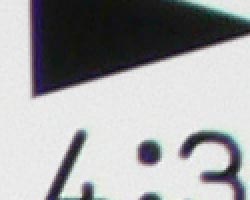 |
|
Wide: very slight, top left @ 200%
|
Wide: same at top right @ 200%
|
 |
 |
|
Tele: brighter but low, top left @200%
|
Tele: same at top right @200%
|
Chromatic aberration is very low at wide angle, showing only about 2-3 pixels of very slight coloration on either side of the target lines. At telephoto, the brightness level increases, but the number of pixels is about the same, the net result still being lower than average chromatic aberration. (This distortion is visible as a very slight colored fringe around the objects at the edges of the field of view on the resolution target.)
Corner Sharpness
Moderate softening in the corners of the frame at both wide angle and telephoto.
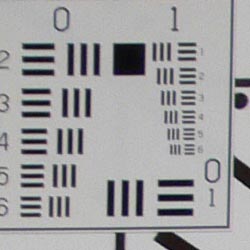 |
 |
|
Wide Angle: Slight blurring,
most in upper left corner. |
Wide Angle:
Sharp at center. |
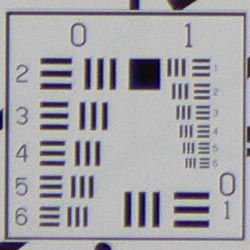 |
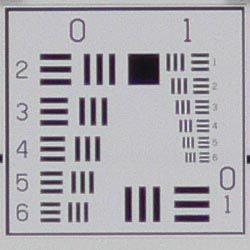 |
|
Telephoto:
Moderate blurring in all four corners. |
Telephoto:
Very slightly soft at center. |
The DMC-FZ30's lens produced slight to moderate blurring in the corners of the frame at both wide angle and telephoto positions. The amount of blurring was slightly greater at telephoto, the center of the frame was also slightly soft.
Sensor
Exposure and White Balance
Indoors, incandescent lighting
Pretty good color with the Manual white balance, about average positive compensation required. (Auto white balance is much better than most.)
| Auto White Balance +1.0 EV | Incandescent WB +1.0 EV |
| Manual White Balance +1.0 EV |
The DMC-FZ30's Manual white balance setting handled the difficult incandescent light best overall. The Auto setting resulted in a red cast and rather ruddy skin tones, but the color balance was still quite a bit better than most cameras manage with this tough light source. The Incandescent setting produced much warmer results. Overall color is pretty good, though Marti's skin tone is a little too pink, even with the Manual setting. Additionally, the blue flowers are quite dark and purplish, though this is very common on this shot. The camera required a +1.0 EV exposure compensation boost to get a good exposure, which is fairly typical for this shot. Our test lighting for this shot is a mixture of 60 and 100 watt household incandescent bulb, a pretty yellow light source, but a very common one in typical home settings here in the US.
Outdoors, daylight
Good color balance, very bright colors (though oversaturated reds). High contrast, but still pretty good exposure accuracy.
|
Auto White Balance,
Auto Exposure |
Auto White Balance,
Auto Exposure |
Outdoors, the DMC-FZ30 generally exposed well, though with slightly high contrast and strong highlights. Still, the highlights and shadows held onto some detail, with moderate to moderately high noise. Overall color accuracy was also good, though the camera tends to push the bright reds and blues quite a bit.
See full set of test images with explanations
See thumbnails of all test and gallery images
Resolution
High resolution, 1,400 lines of strong detail.
Our laboratory resolution chart revealed sharp, distinct line patterns down to about 1,400 lines. Extinction occurred closer to 2,000 lines. Use these numbers to compare with other cameras of similar resolution, or use them to see just what higher resolution can mean in terms of potential detail. Beware that while you might be able to make out what looks like distinct lines at numbers higher than those we've mentioned here, the camera is just doing its best to continue interpreting the lines. If you zoom in and follow them from the wider portions, you'll see the lines converge and reappear several times, so the "lines" are really only artifacts generated by the camera's imaging system.
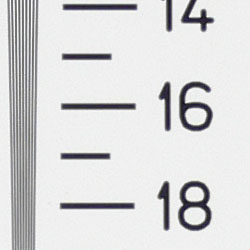 |
|
|
Strong detail to 1,400 lines horizontal
|
Strong detail to 1,400 lines vertical
|
See full set of test images with explanations
See thumbnails of all test and gallery images
Sharpness & Detail
Sharp images overall, though some edge enhancement and moderate noise suppression.
 |
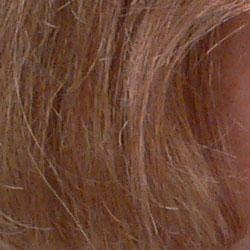 |
|
Good definition of high-contrast elements and fine detail.
|
Subtle detail: Hair
Noise suppression tends to blur detail in areas of subtle contrast, as in the darker parts of Marti's hair here. |
Overall, the DMC-FZ30's images are pretty sharp, with good definition in the finer details. However, some edge enhancement is visible in high-contrast areas, as in the foliage above, though the effect isn't overly strong. (Edge enhancement creates the illusion of sharpness by enhancing colors and tones right at the edge of a rapid transition in color or tone.)
Noise-suppression systems in digital cameras tend to flatten-out detail in areas of subtle contrast. The effects can often be seen in shots of human hair, where the individual strands are lost and an almost "watercolor" look appears. The crop at far right shows moderate suppression, as the darker areas of Marti's hair show limited, mottled-looking detail.
ISO & Noise Performance
Low noise at the low sensitivity setting (softness was caused by subject movement), higher noise but fairly good preservation of subtle subject detail at the higher settings.
 |
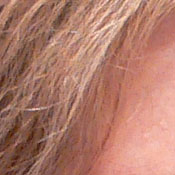 |
|
ISO 80
|
ISO 100
|
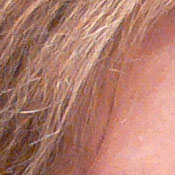 |
 |
|
ISO 200
|
ISO 400
|
The DMC-FZ30's lower ISO settings produced relatively low noise levels, although some noise will still be visible to those with sharp eyes for such things. (The blurring in the image linked above is due to subject movement, not the camera's anti-noise processing.) At the higher ISO settings of 200 and 400, the noise pattern appeared much stronger and brighter, although fine subject detail was preserved quite well by the camera's noise-suppression algorithms. The noise level at ISO 400 is higher than some of its competition, and 8x10 inch prints definitely look rough, although probably still usable for display on a wall, where they'd not normally be viewed any closer than 20 inches (~50 cm) or so.
Extremes: Sunlit and low light tests
High resolution with good overall detail, though high contrast limits detail in both highlights and shadow areas. Very good low-light performance, capable of capturing bright images under average city street lighting and darker conditions.
|
Normal
|
+0.3EV
|
+0.7EV
|
Sunlight:
Because digital cameras are more like slide film than negative film (in that they tend to have a more limited tonal range), we test them in the harshest situations to see how they handle scenes with bright highlights and dark shadows, as well as what kind of sensitivity they have in low light. The shot above is designed to mimic the very harsh, contrasty effect of direct noonday sunlight, a very tough challenge for most digital cameras. (You can read details of this test here.)
The DMC-FZ30 required less positive exposure compensation than average on this shot, at +0.3 EV, although there was an odd decrease in brightness, in going from 0.3 to 0.7 EV of adjustment. Contrast is high, with strong highlights and deep shadows. (And yes, the lighting was absolutely constant between the three shots shown above.) Detail is limited in the deepest shadows, with moderately high noise, and the highlights also lack detail in the hottest spots. (In "real life" though, be sure to use fill flash in situations like the one shown above; it's better to shoot in the shade when possible.)
Low light:
The DMC-FZ30 performed very well on our low-light test, capturing bright images at the lowest light levels we test at, at all four ISO settings. The camera's Auto white balance setting performed well, capturing good color even at the slower exposures. The camera's autofocus system worked well, able to focus on the subject down to the the 1/8 foot-candle light level with the AF-assist light turned off, and well past the lowest light level with AF assist enabled. Do keep in mind though, that the DMC-FZ30's very long shutter times absolutely demand the use of a tripod or other camera support to get sharp photos. (A useful trick is to just prop the camera on a convenient surface, and use its self-timer to release the shutter. This avoids any jiggling from your finger pressing the shutter button, and can work quite well when you don't have a tripod handy.)
Color
Saturation & Hue Accuracy
Highly saturated color, with very strong reds and blues, and rather warm skin tones.
The other important part of color rendition is hue accuracy. Hue is "what color" the color is. Here, the DMC-FZ30 doesn't do too badly. It shows the usual slight shift of cyans towards blue, a common tactic to produce more appealing sky colors, but also shifts orange hues slightly towards red, and purples a bit towards blue. Images of real-world subjects for the most part look pretty hue-accurate though, just brighter than real life.
Our random "Gallery" shots showed very pleasing color across a wide variety of subjects. (See our Panasonic Lumix DMC-FZ30 Photo Gallery for more shots taken with the camera.)
Viewfinder
Coverage
Good accuracy with both the electronic optical viewfinder (EVF) and LCD monitor.
| 35mm eq., EVF | 420mm eq., EVF |
| 35mm eq., LCD monitor | 420mm eq., LCD monitor |
The DMC-FZ30's electronic optical viewfinder (EVF) and LCD monitor showed identical results here, at over 100% frame accuracy at wide angle, and 99% at telephoto. (These shots serve the dual purpose of showing flash coverage, so the telephoto example is rather dark, the FX30's long zoom placing the target beyond the flash's range at maximum tele.)
Flash
Coverage and Range
A fairly bright flash, with good coverage and good range. About average positive exposure compensation required.
| 35mm equivalent | 420mm equivalent |
| Normal Flash +1.0 EV | Slow-Sync Flash +1.7 EV |
Flash coverage was only a little uneven at wide angle, with slight falloff in the corners of the frame. At full telephoto, the camera is too far for the flash to be of any real use. In the Indoor test, the DMC-FZ30's flash underexposed our subject at its default setting, requiring a +1.0 EV exposure compensation adjustment for the best results. Though flash coverage isn't too bad at +0.7 EV, the dimmer exposure has a stronger orange cast that becomes less evident at +1.0 EV. The camera's Slow-Sync mode actually required more exposure compensation, at +1.7 EV, though more for decreasing the orange cast than brightening the exposure. Coverage is a little more even with Slow-Sync mode, though results are still pretty good in the normal mode.
| 8 ft | 9 ft | 10 ft | 11 ft | 12 ft | 13 ft | 14 ft |
1/30 sec f3.6 ISO 100 |
1/30 sec f3.6 ISO 100 |
1/30 sec f3.6 ISO 100 |
1/30 sec f3.6 ISO 100 |
1/30 sec f3.6 ISO 100 |
1/30 sec f3.6 ISO 100 |
1/30 sec f3.6 ISO 100 |
In our flash range test, the DMC-FZ30's built-in flash produced bright, consistent results all the way to 14 feet from the target, doing much better than most cameras we test.
Output Quality
Print Quality
Excellent print quality, bright but appealing color, unusually sharp 13x19 inch prints. ISO 400 images are rough at 8x10, but quite acceptable at 5x7.
Testing hundreds of digital cameras, we've found that you can only tell just so much about a camera's image quality by viewing its images on-screen. Ultimately, there's no substitute for printing a lot of images and examining them closely. For this reason, we now routinely print sample images from the cameras we test on our Canon i9900 studio printer, and on the Canon iP5000 here in the office. (See the Canon i9900 review for details on that model.)
The Panasonic FZ30's images produced unusually sharp 13x19 inch prints, and would likely hold together well enough even at considerably larger print sizes, or with a fair bit of cropping. Its high-ISO performance was less stellar, as its ISO 400 shots were rough at 8x10 inches, albeit acceptable when viewed at arm's length (that is, they'd probably be OK for display on a wall, where they wouldn't be closely scrutinized, but you almost certainly wouldn't want viewers squinting at them up close). At 5x7, ISO 400 noise was visible, but at a level likely to be acceptable to most users. ISO 200 shots were a little rough at 8x10 inches, but would probably be acceptable to most people at that size.
Timing and Performance
Lumix DMC-FZ30 Timing
Very good speed overall.
|
Startup/Shutdown:
|
|
|
Power On to first shot
|
1.0 seconds
|
|
Shutter response (Lag Time):
|
|
|
Full Autofocus Wide
|
0.56 second
|
|
Full Autofocus Tele
|
0.57 second
|
|
Prefocused
|
0.131 second
|
|
Cycle time (shot to shot)
|
|
|
Normal large/fine JPEG
|
1.20 seconds
|
|
Flash recycling
|
6 seconds
|
|
Continuous mode
|
0.37 second
2.73 frames/second (5 large/fine frames) |
|
Download speed
|
|
|
Windows Computer, USB 2.0
|
770 KBytes/sec
|
The DMC-FZ30 showed very good overall performance, starting with a quick 1.0-second startup time. Shutter lag is a fair bit better than average at both wide angle and telephoto. Prefocusing the camera (by half-pressing and holding down the shutter button prior to the shot itself) drops the shutter delay to 0.131 second, a little on the slow side of average these days. Shot-to-shot cycle time for large/fine files is also fairly zippy at 1.20 seconds. In Continuous-mode, at the High setting, cycle times average 0.37 second (2.73 frames per second), fairly average for this class of camera. The flash takes about six seconds to recharge after a full-power shot, also about average, but quite good considering the power of the FZ30's flash. Connected to a computer, download speeds are fast enough that you probably won't feel the need for a separate card reader for faster downloads. Though not speedy enough for professional sports photographers, the DMC-FZ30 is a responsive camera, suitable for family and kid portraits as well as sporting events.
Battery and Storage Capacity
Battery
Moderate battery life with the LCD on or off, definitely consider buying a second battery.
|
Still-image capture mode
LCD on |
146 minutes
|
|
Still-image capture mode
LCD off |
152 minutes
|
|
Image playback
LCD on |
252 minutes
|
The Lumix DMC-FZ30 uses a custom rechargeable LiIon battery for power. The table above shows maximum run times based on our power measurements and the rated capacity of its battery. These aren't terrible run times, but by the same token aren't nearly as good as some of its competition. Given the fairly short run time with or without the LCD enabled, you should definitely consider purchasing a second battery to pack along on extended outings.
Storage
A 16MB card is included with the Panasonic Lumix DMC-FZ30.
16MB SD Card |
Fine | |
| 3,264 x 2,448 | Images | 3 |
| File Size | 4.1 MB | |
| 2,560 x 1,920 | Images | 6 |
| File Size | 2.5 MB | |
| 2,048 x 1,536 | Images | 9 |
| File Size | 1.7 MB | |
| Images | 15 | |
| File Size | 1.0 MB | |
| Images | 23 | |
| File Size | 683K | |
I strongly recommend buying Large capacity SD/MMC memory card, to give yourself extra space for extended outings (These days, 128 - 256 MB is a good trade-off between cost and capacity.)
Conclusion
| Pro: | Con: |
|---|---|
|
|
Without a doubt, the Panasonic FZ30 is one of the stronger entries at the top end of the "enthusiast" all-in-one digital camera range. Its performance and specs may not quite match those of typical digital SLRs, but when you consider the superb optical quality of its image-stabilized 12x Leica zoom len, you'd have to pay literally a couple of thousand dollars to match its reach with a SLR body and kit of two or three zoom lenses. (You could certainly match the zoom range for less money than that, but matching the optical quality and image stabilization capability of FZ30's lens would be expensive indeed.) Image quality overall is very good, with excellent resolution and sharpness and bright, saturated but hue-accurate color. (If you like more understated color, you could find the FZ30's color a bit too much of a good thing, particularly in the blues and reds, but we suspect most consumers will find it very appealing.) The one negative point against the camera is its somewhat higher than average noise levels. As always though, we need to emphasize the importance of judging image noise in printed photos, rather than 1:1 on a computer display. Noise that seems dramatically obvious on-screen can become a non-issue at normal print sizes. The FZ30's ISO 400 photos are a little rough when printed at 8x10 inches (albeit usable for wall display), but look just fine when printed at 5x7 inches. ISO 200 shots look fine at 8x10. With a full range of exposure control modes, including a full manual setting and no less than 14 preset "Scene" modes, the DMC-FZ30 is an approachable camera for both novices and more experienced users alike. Bottom line, the Panasonic Lumix FZ30 is a very strong player at the upper end of the all-in-one digital camera field, and represents an excellent bargain for anyone interested in a long zoom range, optical stabilization, high resolution, and responsive performance. We'd like to see less image noise at higher ISOs, but the FZ30 is a virtual shoo-in for a Dave's Pick.
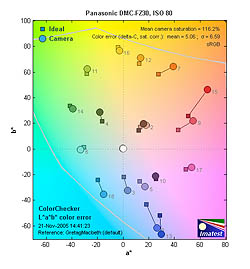

Follow Imaging Resource: